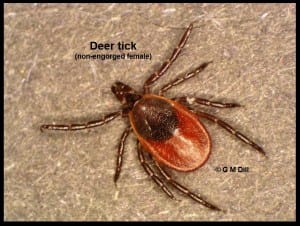By Heather Haycock for UConn Extension

Summer in Connecticut is the perfect time to get outside and enjoy the sunshine. There are beautiful trails to hike, parks to visit with your children or dogs, and there is the simple joy of lying in the lush, green grass. Of course, the warm weather also comes with the New England outdoor enthusiast’s nemesis – the tick. These disease-carrying arachnids enjoy moist areas with long grass and will latch onto humans and animals alike. Although there are many different species of tick, people generally think of one tick species in particular when worrying about illness: the deer tick. While the deer tick is predominantly known for transmitting Lyme disease (caused by the spirochetal bacterium, Borrelia burgdorferi) it can also carry other disease causing agents such as Anaplasma phagocytophilum and Babesia microti. These are the causative agents of Human Granulocytic Anaplasmosis and Babesiosis respectively. A single tick has the potential to transmit one, two, or even all three of these illnesses simultaneously!
If you find a tick on yourself, your child, or your pet, remove it immediately! The Connecticut Veterinary Medical Diagnostic Laboratory (CVMDL) can test the tick for pathogens. Ticks received at the CVMDL are first observed under a microscope by trained technicians to determine the species of tick, life stage, and degree of blood engorgement, all of which are factors that may impact transmission of pathogens to the person or animal. Ticks may then be tested for the DNA of pathogens that are common to that tick species. Results are reported within 3-5 business days of receiving the sample, and next day testing is available for an additional fee.
How to send in ticks: Please send ticks in sealed zip lock bags accompanied by a small square of moist paper towel. The submission form, pricing and the “Do’s and Don’ts of tick testing” can be found on our website.